Training flying personnel is time-consuming and cost-intensive. A look abroad shows how innovative concepts could increase the availability of personnel and material.
At the beginning of April, Eva Högl, the Defence Commissioner of the German Bundestag, was quoted as saying the following about the Bundeswehr: "The challenge with personnel is even greater than with material." Although the procurement of modern weapons systems, ammunition and spare parts was and is to a certain extent a prerequisite for successful recruitment, Högl is right.
But what can be done to avert a personnel shortage? Is it enough to do more advertising for the armed forces? Do we need financial incentives or do we need to change the framework conditions? Advertising is transparent. If it does not reflect reality, it is counterproductive, creates false expectations and attracts the wrong target group. Financial incentives are usually only effective for a short time and can be used even more flexibly by civilian employers, so that only limited success can be expected here.
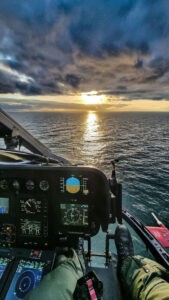
View from an EC 135, photo: Bw/Höser
So it has to be the framework conditions. Modern people management and catering to the needs of young people should be a matter of course. Other parameters can hardly be changed. You can't drive tanks, work on aircraft or go to sea from a home office. Deployments abroad will always involve risks and require absences of several months, and barracks cannot be relocated to attractive population centres across the board. The Bundeswehr has already made more flexible use of the existing scope for organising home office and teleworking, parental leave and the like than many would have expected.
What other options do we have? In addition to reducing personnel requirements, for example through automation, AI-based support and unmanned systems, training offers an effective lever. Modern training can be attractive in itself, increase the operational value of a soldier and his equipment - and save time. Every day gained in this way increases the availability of personnel for the core task of deployment and reduces the need for regeneration.
Pilots and aircraft operations officers generally receive a degree in addition to their pilot and officer training. In total, they undergo around ten years of training before they are ready for deployment as a pilot or tactical officer. This means that regular soldiers are only available for five to six years in the post for which they were trained. A ratio of 2:1 to the detriment of the "operational benefit"! The ratio is hardly any better for professional soldiers, as they enter staff officer training at a similar time and then often no longer find a post in the flying squadrons or have to focus on organisational tasks.
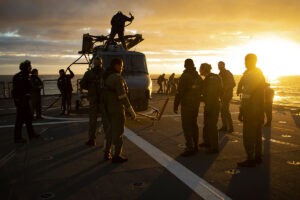
Flight operations are always teamwork, photo: Bw/M. Mey
Technology makes you independent
Modern training can do something else: save money and free up cost-intensive weapon systems for deployment. One flying hour in a modern weapon system costs several tens of thousands of euros. One reason for these high costs is the maintenance-intensive nature of complex systems. The consequence of this is the limited availability of aircraft in the constant balancing of training and operational requirements. Even civilian training models often cost only a fraction of military weapon systems to maintain, but can cover a considerable proportion of training requirements. Simulation options can further reduce the cost factor and depict operational scenarios that cannot even be practised in the original weapon system. In addition to the fully manoeuvrable flight simulator, systems that do not require three-axis manoeuvrability or only depict individual tasks or processes (so-called part task trainers and procedure trainers) have become increasingly popular over the years. In addition, technology now also makes it possible to take training out of the classroom. Virtual, augmented and mixed reality training make technical and flying training independent of curricula and school buildings. They pick up on the learning habits of Generation Z, are more memorable, make content tangible and can therefore be taught more effectively, quickly and sustainably. Waiting times for the start of training sections are reduced and opportunities are created to complete sections remotely.
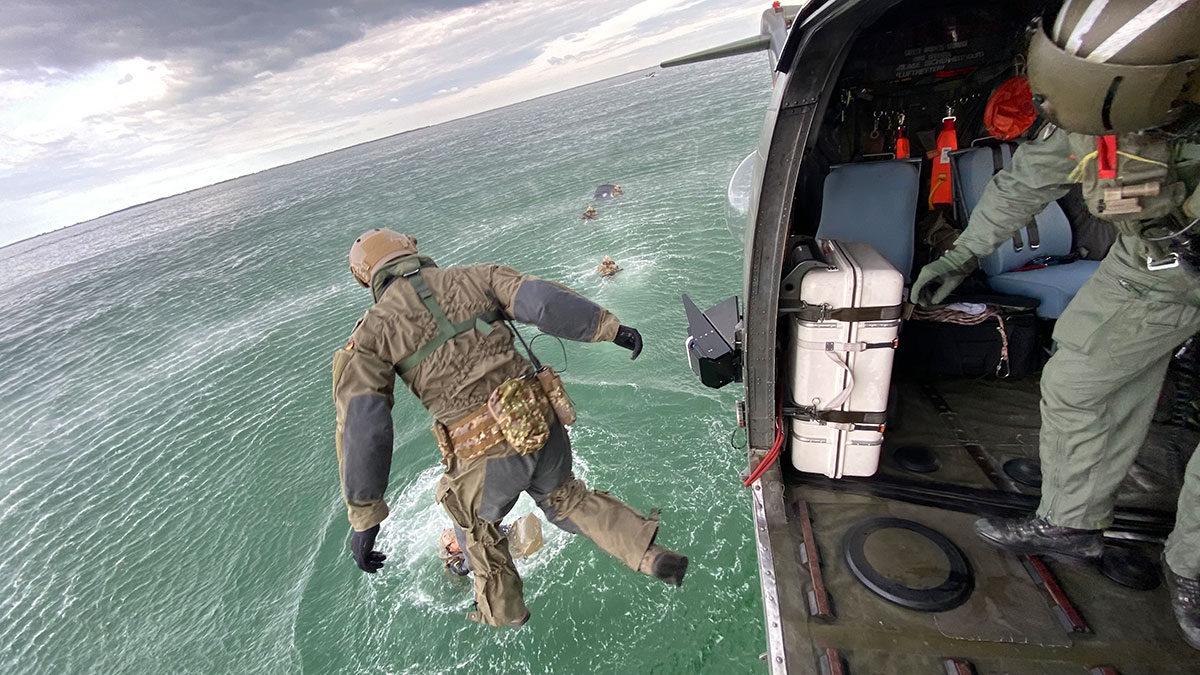
KSK soldiers jumping out of a Sea King, photo: Bw/Lehmann-Götz
However, it is not only the training resources that are subject to the dual burden of training and operational requirements, but also the instructors. In times of scarce flight hour quotas, it is often the instructors who have the most experience and are called upon during missions. When they are deployed, training is suspended and no experience is gained for tomorrow's missions. This is neither attractive nor effective. Cooperation with the industry promises a quick remedy.
As obvious as the benefits and cost savings are, the Bundeswehr is still struggling to capitalise on them. Admittedly, outsourcing rightly does not enjoy the best reputation everywhere. Industry cannot do everything better or more cheaply than the Bundeswehr. Many endeavours had to be scaled back at great expense in order to cover requirements and regain control. On the other hand, the Bundeswehr's procurement processes are still not compatible with fast-moving, particularly digital developments, and an additional instructor in uniform that is needed today should have been hired ten years ago. It therefore depends on the right mix and close support.
Simple, available, affordable
With the Light Utility Helicopter Streitkräfte (LUH SK) as the future training model for helicopter crews, the navy has embarked on such a path. There is no need to procure or develop its own training helicopter, nor is there any need for infrastructure, technicians or flight instructors. None of this would be available or could be procured quickly enough. Instead, a civilian company is to provide training content on a civilian helicopter that is similar to the NH 90 naval helicopter in terms of flight and mission control, in accordance with the strict specifications of the navy. Standards will be reviewed by the navy, but the training will be provided by a civilian company. The aim is to introduce young crew members from basic helicopter training at the Army's International Helicopter Training Centre in Bückeburg to maritime tasks, the Navy's complex weapon system, a crew concept and, of course, the maritime environment, including flight operations on and off a ship. Training elements that would otherwise have to be carried out by operational pilots on the Navy's expensive and scarcely available operational models. This should be ready by mid-2024. Just in time to secure the transition to Sea Lion and Sea Tiger, the naval variants of the NH 90.
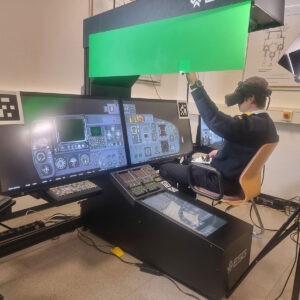
Demonstrator for Part Task Trainer with augmented reality, photo: Bw/Lehmann-Götz
There are also numerous approaches for simulation tasks. The spectrum ranges from apps for private mobile phones with unclassified, even gamified training content to virtual reality goggles for experiencing operational tasks and largely stationary consoles with flight simulation software and a pilot's chair. The naval aviators have already made several business cases in this area and have met with much approval. However, none of the ideas have yet been translated into a concrete project. Despite many innovation forges, there is a lack of structured transfer of good ideas into standardised procurement.
Another gap in flight training is the platform required for flight deck training. A fleet that is in great demand on missions but is shrinking and in need of overhaul is less and less able to provide this, while demand is increasing rapidly with the growth and retraining of naval pilots.
No matter how operational a fleet is, a military unit will always be more manpower-intensive and more expensive than a training ship. A rented unit would cost 60,000 to 70,000 euros per day and would be available for planning. The cost of a frigate is around 200,000 euros per day, and the ship is not even available for training in a plannable manner. This shortcoming could certainly be optimised within the framework of availability management. However, this would turn the shortage into an optimised shortage at best. So why plan a fleet that covers 100 per cent of training requirements instead of concentrating on deployment and training close to deployment?
Born out of the necessity of not being able to generate enough sea days for the combat units for the required training sections, the Royal Australian Navy commissioned the civilian ship Sycamore as a multi-role aviation training vessel (MATV) at the beginning of 2018. In addition to its main task of flight deck training for helicopter crews, the Sycamore with its crew of just 19 people is also available for training divers and navigation officers as well as for mine defence and torpedo recovery exercises. While it was initially assumed that around 100 sea days per year would be required, a second unit is already being considered Down Under despite a capacity of more than 300 sea days due to the high utilisation rate.
Demand everywhere
There are comparable requirements in many European navies. A test phase planned by the Dutch navy for 2022 and 2023 with a chartered offshore oil rig supply vessel only failed due to a lack of budget funds. The UK and Norway articulate a need, but hope to be able to join another nation's corresponding project.
The need for the German Navy has been formulated for years. However, in view of higher-priority procurement projects for flying and floating combat units, the leasing of a civilian training unit has not yet been realised. The fact that flight deck training is not only required for the deck landing qualification of flying crews, but also for the bridge, OPZ and flight deck personnel of ships and boats, has also prevented its realisation. Ideally, this training should therefore also take place on units that have a flight deck, in line with the principle of train as you fight.
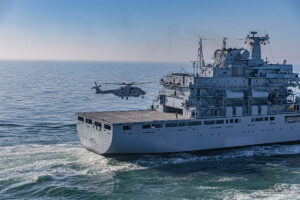
Landing of an NH 90 at the EGV Bonn, photo: Bw
However, this did not change the lack of capacity to make sea days available for such training. When prioritising other projects, insufficient consideration was therefore given to the fact that a training unit that is available for up to 300 days at sea exclusively for various training purposes frees up at least as many days of significantly more personnel and cost-intensive high value assets of the German Navy for missions and mission-related obligations.
Civilian companies are certainly offering to procure or even provide existing units which, like the Australian Sycamore, could also provide diver and navigation training in the North Sea or Baltic Sea in addition to flight deck training if required. Realisation would be possible as early as 2025 on the industry side and the start of service would presumably be defined by internal Bundeswehr procurement processes. Similar to the Australian Navy, the German Navy has a prospective requirement of around 110 days at sea for deck landing qualifications, flight deck and helicopter controller training as well as training maintenance. From an economic point of view, renting a training unit for this alone would be extremely sensible. As the navy's training boats are not expected until around 2028 (project sea-based naval training and sea trials - without flight deck, SAMSe), further training gaps could even be closed for a transitional period. Considering the training requirements and potential for divers, mine defence and other fields, as well as the interest of other NATO navies in the North Sea region, it would hardly be surprising if this unit were to quickly reach its capacity limit of 300 sea days.
The navy has also set the ball rolling here. Now it is up to the planning office to find a way to realise it. For the German Navy, this not only means increased availability of its valuable and expensive combat and support units. It would also significantly accelerate flying and technical training courses and contribute to professionalisation and increased attractiveness. High-quality armed forces personnel would be trained faster and better and would be available for their actual task for longer. A cornerstone against the personnel shortage in the sense of the defence commissioner would be laid.
Thorsten Bobzin
Captain Thorsten Bobzin is Head of Division at the Federal Ministry of Defence.


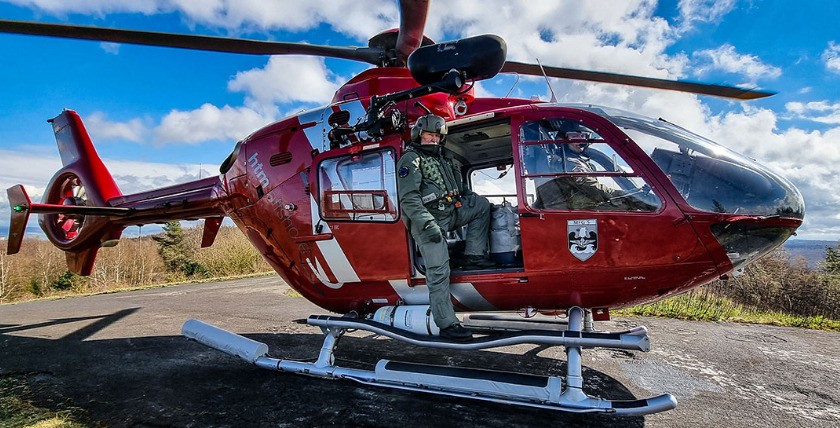








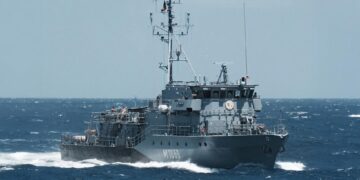
0 Kommentare